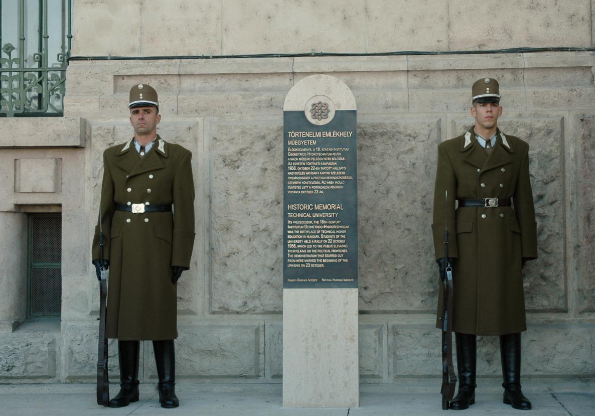BME’s historical significance

The historical significance of BME in 1956
The events at BME had a decisive impact on the events of 1956. The university youth of the time formulated the points at the student assembly of BME on 22 October that formed the basis of the political programme of the protests and the revolution that broke out.
The next day, on 23 October, the students of BME reproduced thousands of copies of the points made and distributed the leaflets in the city.
On the afternoon of 23 October, a silent demonstration in solidarity with Polish workers set off from BME. The event was followed later that evening by the toppling of the Stalin statue, the siege of the radio building and the outbreak of the War of Independence.

Until November 4, 1956, BME functioned as an important organizing and distribution centre, while the National Guard, which was established in an organized form, performed law enforcement functions throughout the city. Education only resumed in February 1957, after the suppression of the Revolution and War of Independence.


The details of the revolutionary events related to BME were compiled by Krisztina Batalka, head of the archives of BME OMIKK. The article was also featured in the volume "Hungarian Higher Education Institutions in the 1956 Revolution and War of Independence".
Former rector Árpád Précsényi took photos of the march, which were made available to the university by his family.
BME 1956 - The Freedom of the Youth 2016
In 2016, on the 60th anniversary of the 1956 Revolution and War of Independence, BME paid tribute to the historical event and its protagonists with new initiatives, programmes and written compilations, in addition to the traditions that have been preserved for decades.
The programme was supported by the 1956 Commemorative Committee.
Designation of BME as a Historical Memorial Site
On the basis of Government Decree 313/2016. (X. 19.), on 23 October 2016, BME became a historical memorial site.
The stele with inscriptions in Hungarian and English, created by the National Heritage Institute, is located next to the main entrance of the central building.

Commemorative Medal
To mark the anniversary, a commemorative medal was also awarded to former citizens of the university and our guests. The coin is the artistic creation of Róbert Csíkszentmihályi, formed by master engraver Géza Szabó.



Light painting
On 22 and 23 October 2016, from 6 pm to 12 am, the central and “Ch” buildings of BME was illuminated by a special 1956-themed light show.
Documentary
In the documentary “The Youth of BME. Recollections", produced with the help of the students of Budavári Schönherz Stúdió, students ask the questions, and also hold the camera and the microphone. In this way, one of the most important goals of the commemorative programme can be achieved: in addition to deepening the sensitivity and knowledge of student filmmakers, it is through their perspective that the young generations of today can learn about what 1956 meant and can mean for the descendants today. The documentary was also made for educational purposes.
János Frivaldszky Sr.: Engineers of the future
The volume is a collection of hitherto unknown or less publicised diaries, interviews, recollections, documents and photographs, addressed to any reader of today, especially, of course, to today's BME students. It is because in this volume not BME students of the National Guard are in the spotlight, but those who experienced the beginning of a promising future in the events of the revolution, pointing towards a society unencumbered by the defects of socialism and capitalism. And they have taken on tasks to achieve this that are truly worthy of engineers. It also demonstrates the institution-building nature of 1956, which was real, even if it was crushed by the Soviet tanks along with the revolution.
Eryk Bazylczuk: Hungary 1956 - memories in pictures
Eryk Bazylczuk had stayed in Hungary from the autumn of 1953 as a Polish state scholarship student at the Faculty of Electrical Engineering of BME. He took part in the rally in the Assembly Hall on 22 October 1956 and in the preceding meetings in the student hostel in the Castle District, and was among the students marching to the Bem statue on 23 October. He survived the events, graduated in 1957 and returned to Poland. He has never lost touch with the country or his university mates (he took part in the 30th class reunion in 1987 and received a gold diploma in 2007). He visited BME again in the autumn of 2015, a few days before his death.
Anthem in the night
The photo interview compilation was prepared by BME lecturer, honorary university professor József Németh.
